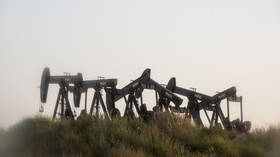Is this the beginning of a US shale crisis?

Banks are restricting lending and revising their estimates on the value of some shale reserves, according to the Wall Street Journal.
Even the largest banks, such as JPMorgan Chase and Capitol One Financial Corp., are expected to cut their exposure to the shale industry. Sources told the WSJ that the banks are growing more concerned that if drillers go bankrupt, their assets – the value of which could be declining – may not cover the outstanding loans.
The scrambling among big financial institutions comes as the industry is being hit by a wave of write downs. Chevron said earlier this month that it expects to take a $10 to $11 billion write down, largely the result of weak assets in Appalachia and a big LNG project in Canada. Last week, Royal Dutch Shell said that it would write down $1.7 to $2.3 billion in assets in the fourth quarter, although the company declined to offer more details.
Also on rt.com Shale’s debt-fueled drilling boom is coming to an endIn recent months, other big oil companies also reported write downs, including Repsol BP, Equinor and Halliburton.
But the oil majors aren’t in any danger of going bankrupt. Weaker shale drillers pose a bigger risk to banks because some may be unable to pay back debt. Roughly 200 oil and gas companies have gone bankrupt in North America since 2015, according to Haynes & Boone. More than 30 bankruptcies have occurred in 2019, the highest number in three years. Energy companies accounted for more than 90 percent of defaults on corporate debt in the third quarter, the WSJ noted, using Moody’s data.
Haynes & Boone estimates that banks could cut their credit lines to the sector by as much as 10 percent. But, that is an industry-wide average. For individual companies that are in a weak position, the reductions will be much more significant. Meanwhile, according to Credit Benchmark, roughly 22 oil and gas companies saw their credit ratings upgraded by a variety of financial institutions in November, while 33 saw their ratings downgraded.
If the spigot of capital flowing from Wall Street into West Texas is tightened, drilling and production could continue to slow.
Also on rt.com The real history of fracking: Oil, bombs and civil warThe Dallas Fed recently revealed that broader lending growth in West Texas has slowed dramatically. The value of loans in West Texas grew by 4.8 percent in the third quarter, compared to 7.5 percent in the rest of the state. Loan value for apartments and other housing fell by 15 percent, compared to an increase of 12 percent in the rest of Texas. Home inventories are now on the rise.
On the ground, the effects are becoming increasingly visible. The Permian is shedding jobs and vacancies in corporate office space have increased.
The problem plaguing the shale sector is more damning than just overly optimistic profit forecasts from oil executives. The issue is also one of disappointing operational results, which cuts to the heart of the problem with shale. Put bluntly, shale wells are not producing as much oil as advertised, and in the aggregate, they are declining at faster rates than the industry promised, as the WSJ has reported over the past year.
Also on rt.com The 10 most important oil market trends for 2020If shale wells ultimately produce less over their lifetimes than companies advertised to their investors, then the companies themselves are likely worth a lot less than previously thought. They will produce less oil and gas, less cash flow and even the unproduced reserves they are sitting on could suddenly be worth much less than previously thought.
That has massive implications for the entire sector. The problem is crystallized in a quote from Michelle Foss, an energy fellow at Rice University’s Baker Institute for Public Policy. “There is a struggle now for investors to determine what things are actually worth,” Foss told the WSJ.
This article was originally published on Oilprice.com













